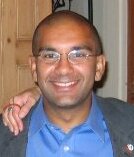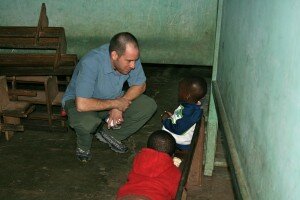 by Greg Heinrich, Mobilization Manager, AmeriCorps Alums
by Greg Heinrich, Mobilization Manager, AmeriCorps Alums
It’s been five years since Hurricane Katrina ravaged the Gulf Coast, and as a person who was born and raised in the region, it has been five years of ups and downs.
As a native of the New Orleans metro area, my youth was filled with memories of the unique New Orleans culture, one that is a true asset to our country.
The food, the music, the fun, the history, the New Orleans accent and the sense of community are all traits that combine to make one of this country’s most appealing and interesting cities.
After Katrina, many of the people who make-up of that culture were displaced, some temporarily and some permanently.
Even though I was not a resident of the area during the storm, I vividly remember the images being broadcast across the networks: bodies floating in the water, residents pleading for help from the rooftops, armed troops patrolling the streets- U.S. streets- as though they were preparing to subdue an enemy that could erupt violently at any moment, and the hungry, huddled masses gathered at the Morial Convention Center.
These are all terrifying and saddening images that will always be with me to serve as a reminder that even the abilities of one of the most advanced nations that civilization has ever seen can be crippled in the face of nature’s fury and a disconnected government response.
And there is also the more personal, anxiety-filled memory of the inability to communicate with family because nearly most of the communications infrastructure was non-operational. Are they all right? Is our home flooded or completely washed away? How long until power is restored?
These and myriad other questions were flowing through my mind, and even now I return to that state anxiousness just by thinking about it.
I remember badly wanting to offer assistance to the evacuees headed to Atlanta where I now live.
I volunteered at local resource distribution centers to organize products being donated to those affected by Hurricane Katrina.
It didn’t seem like that was enough though, so I worked with a friend and colleague to identify relocated families who needed financial assistance in the aftermath of Katrina.
Still, I had yet to see first-hand the new reality of my hometown.
In December, 2005 I was finally able to make my way down to the New Orleans metro area, and what I witnessed was a region that was literally ripped to shreds.
Homes uprooted from their foundations and littered on the sides of roads as if they were rag dolls, entire neighborhoods like ghost towns because either the residents decided to permanently relocate or had no resources to get down to the work of rebuilding, the camps- where I spent weekends as a youth- on Lake Pontchartain completely wiped out, and at night there were spots of complete darkness because street lights were not working and several neighborhoods had a large percentage of residents who had not returned to their homes.
The devastation was the most incredible example of nature’s power I had ever seen in such an up close and personal way.
But one thing was clear, the spirit and perseverance of the people of New Orleans would play a key role in helping to rebuild New Orleans.
Certainly, the business of rebuilding a stronger, better New Orleans would be a tough order. But perhaps a Home Depot billboard I saw summed it up best.
It said:
“Rebuilding New Orleans: You can do it. We can help.”
That was then.
Now, five years later, New Orleans has faced its share of challenges during the recovery, but it has also made significant strides.
Based on mail delivery statistics, the population is only around 80% of the pre-Katrina population, and it is hard to gauge much of that 80% consists of transplants who relocated to New Orleans because of the storm (i.e. volunteers).
The Road Home program is viewed by many to have been an inefficient boondoggle that has served to frustrate more citizens than it has helped.
The murder rate is the highest, per-capita, in the nation, not a good statistic to have if you are looking to attract new and returning citizens to your city.
All of these are significant challenges facing the city of New Orleans.
But then, there are other areas that have seen astonishing improvement, so much so that they are being looked at as models for other parts of the country.
Right now, over 70% of the students in New Orleans are attending charter schools, and a voucher program has been implemented to allow children in failing public schools to attend private schools.
The education revolution has led to more competition among schools and more education options for the children of New Orleans.
Currently, New Orleans is the most market-based school district in the nation.
The results point to increased student performance and rising test scores.
As an AmeriCorps alum, I would also be derelict in my duties if I did not mention the role that AmeriCorps members, AmeriCorps alumni, and other volunteers have played in the recovery effort.
The city has experienced a volunteer boom over the past five years, and through it has effectively tapped into the collective knowledge and passion of volunteers to help rebuild and restore the New Orleans metro area.
Because of its effective utilization of volunteers over the past five years, New Orleans has attracted the world’s largest conference on volunteering and service. (The 2011 National Conference on Volunteering and Service will be held in New Orleans in June, 2011.)
Then, there has been the opportunity to thoughtfully plan how to rebuild.
The silver lining in the destruction of the city was that New Orleans could look to rebuild in a way that took into account energy efficiency and environmental responsibility, an opportunity New Orleans has seized upon to become a frontier for a city-wide green revolution.
One organization, Global Green, is embarking on a lofty plan to rebuild 10,000 green homes.
Strides like these help point to the viability and resurgence of the city.
Then, there are those things that are much the same.
Although it may have lost some of its people, the essence of the city remains intact, and this is what makes New Orleans one of the most unique cities in the world.
The food is still deliciously mouth watering.
The bustling, busy streets of the French Quarter are still filled with vendors and street performers.
The oak trees that line St. Charles Avenue in such a welcoming manner still remain.
The genial residents of the city have maintained their friendly hospitality.
The soulful bar music spilling into passerby’s ears and onto the brick-covered streets remains a unique, New Orleans characteristic.
The pride, unification and utter joy that a city can experience all because of its football team are still part of the fabric of New Orleans.
While Hurricane Katrina may have altered New Orleans in some ways, now as then, it has not changed its heart, it has not changed its soul, and it has not changed its spirit.
 It’s AmeriCorps week, and we thought we’d take a day to point out why we love AmeriCorps and the great people that sign up to serve every year!
It’s AmeriCorps week, and we thought we’d take a day to point out why we love AmeriCorps and the great people that sign up to serve every year!


 In case any of you hadn’t heard, Jer Clifton was the man who pulled a man to safety after he had fallen onto the train tracks in the Atlanta Subway. You can see his efforts
In case any of you hadn’t heard, Jer Clifton was the man who pulled a man to safety after he had fallen onto the train tracks in the Atlanta Subway. You can see his efforts  Today’s post comes from Whitney Soenksen, External Relations Manager for AmeriCorps Alums
Today’s post comes from Whitney Soenksen, External Relations Manager for AmeriCorps Alums Today’s post comes from Shawn Rubin, AmeriCorps Alum and founder of
Today’s post comes from Shawn Rubin, AmeriCorps Alum and founder of  Using small amounts of money and large quantities of volunteer energy Longitude has been able to equip talented community leaders, in Ghana and India, with the tools and skills they need to increase their impact and efficacy among their people. In just five years Longitude’s partner organizations have grown from small one-man shows funded through meager personal salaries into accountable, locally-run, NGO’s serving hundreds who would otherwise have no options.
Using small amounts of money and large quantities of volunteer energy Longitude has been able to equip talented community leaders, in Ghana and India, with the tools and skills they need to increase their impact and efficacy among their people. In just five years Longitude’s partner organizations have grown from small one-man shows funded through meager personal salaries into accountable, locally-run, NGO’s serving hundreds who would otherwise have no options. Today’s post comes from Whitney Soenksen, External Relations Manager for AmeriCorps Alums
Today’s post comes from Whitney Soenksen, External Relations Manager for AmeriCorps Alums Megan Hill is a New Orleans native and a frequent volunteer. She is a certified nonprofit grant writer and a freelance journalist covering travel, sustainable food, and the environment. Megan is a two-term AmeriCorps alumna and she is writing a memoir about her time in AmeriCorps NCCC.
Megan Hill is a New Orleans native and a frequent volunteer. She is a certified nonprofit grant writer and a freelance journalist covering travel, sustainable food, and the environment. Megan is a two-term AmeriCorps alumna and she is writing a memoir about her time in AmeriCorps NCCC.




 By Whitney Soenksen,
By Whitney Soenksen,  A drawing based on referrals will award the Grand Prize – autographed memorabilia from ServiceNation Youth Chair, Usher.
A drawing based on referrals will award the Grand Prize – autographed memorabilia from ServiceNation Youth Chair, Usher.
